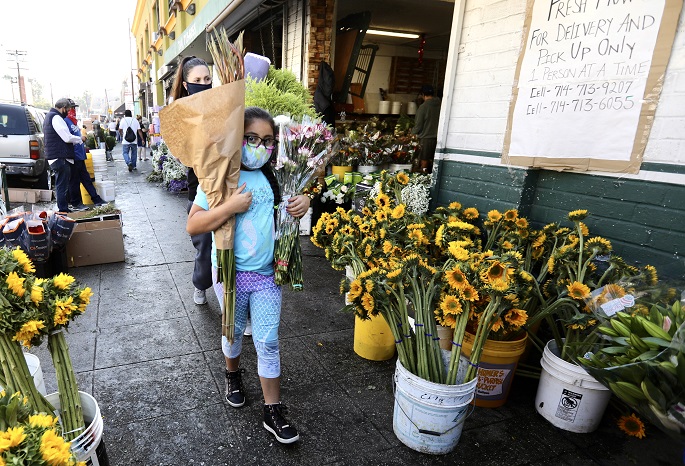Los Angeles loosens stay-at-home order amid controversy
Published : 11 May 2020, 00:34
Under California Governor Gavin Newsom's four-phase guidelines, Los Angeles moved this weekend to reopen sectors of its economy, rolling back restrictions on certain types of businesses and public sites.
While some residents have shown their desires to speed up the reopening steps for local economy, others still believe the lockdown should be loosened more carefully since the county is still laying under the shadow of COVID-19.
EASING RESTRICTIONS
California, with 40 million residents, is the largest state in the United States and was the first to issue stay-at-home orders on March 19. In a concerted effort to slow the spread of COVID-19 and avoid overwhelming the state's public health system, the stay-at-home order temporarily shuttered retail shops and businesses that required people to be in close proximity.
For the first time after an almost two-month lockdown, some lower-risk retail businesses are being allowed to reopen since Friday, including bookstores, clothing and toy stores, florists, sporting goods, and take-out restaurants, amongst others, but only for curbside delivery.
No in-store shopping is allowed and business owners are encouraged to provide hand sanitizer to their customers and staff and to make use of hands-free payment devices to limit possible contamination vectors.
"We're moving away now from 'essential' and 'non-essential' to 'lower risk' (businesses)," Newsom announced at his daily briefing on the novel coronavirus Friday.
The governor also made it clear that the reopening will not include close-contact businesses, such as hair salons, tattoo parlours, sit-down restaurants and gyms.
The easing of restrictions included reopening state and city hiking trails and beaches starting from Saturday, but again, with stringent social distancing and mask-wearing requirements in place.
Newsom mentioned that these restrictions had a degree of flexibility, so that some local governments with fewer COVID-19 cases could receive variances to open other types of businesses earlier, while others might have to scale back if the number of their infected cases spikes again.
"It is a dynamic process. It is not etched in stone," said Newsom. "At the end of the day, these are meaningful modifications."
FACING CONTROVERSY
Angelenos are taking to their newfound freedom with a vengeance this weekend. Attendance surged at beaches, parks and many just strolled the streets -- in masks of course.
Meanwhile, some 1,500 people in Huntington Beach, a city of Orange County located 60 km south of Los Angeles downtown, waved flags and signs to renew their disapproval with the state's coronavirus restrictions on Saturday.
The protesters, most of whom were seen without facial coverings and also seemingly defying physical distancing guidelines, called the stay-at-home order "absolutely unconstitutional."
In Los Angeles, a much smaller group protested outside Mayor Eric Garcetti's home, pleading for more businesses to reopen their doors. The group argued that all jobs are essential for common life and they want everything from stores to schools and churches to be reopened.
With an estimated 4 million unemployed in California due to the COVID-19 crisis and entire industries at risk, the pressure is mounting to reopen the state's businesses and jump start its economy as soon as possible.
"People need to go back to work," Brad Plows, a Hollywood animator who lost out on gigs due to the lockdown, told Xinhua. "A lot of my friends and colleagues are desperate. At a certain point, if they get desperate enough, they'll go back to work anyway, with or without government permission."
Businessmen showed a complicated feeling.
"Small businesses are the backbone of the American economy," Robert Sun, president of the American Chinese CEO Society, told Xinhua. "Cautious reopening is a crucial step for small businesses, because if they go out of business during the pandemic, the economy loses its lifeblood."
However, Chuck Hamil, an insurance investigator in Chino, California, told Xinhua, "It might be too soon, because Los Angeles showed big secondary spikes during the Spanish Flu when they relaxed restrictions. But, if businesses and their clientele follow the safety rules, it might work."
"I'm all for curbside pick up, but I can wait on getting a haircut," he added.
Mark Ghaly, director of California Health and Human Services, said that stable conditions at Californian hospitals were one of the key determinants that enabled state officials to begin easing restrictions.
He indicated that more businesses sectors, such as on-site dining restaurants, malls, offices, museums, schools and day care centers, will be addressed in the second half of phase two, possibly in June or July.
COPING WITH NEW NORMAL
According to the state's regulation, during phase two, Californian businesses must meet a series of guidelines, including undertaking employee training, finishing risk assessments, and implementing control measures, employee health screenings and physical distancing guidelines, among others.
Phase three involves higher risk businesses that require close personal contact, such as gyms, hair salons, tattoo parlors, film and TV productions, and church services. It could follow not too long after late phase two, but that might be months away.
No date has been estimated for phase four, which involves high-volume, close contact events such as music concerts and sporting events.
California uses six key indicators to determine when it is safe to initiate the next phase, which include maintaining an ongoing availability of hospital beds, access to widespread testing, and reliable tracing systems to identify and isolate secondary infection vectors before they can escalate.
Robert Lawrence Kuhn, a high-profile on-air host, writer, commentator and documentarian, told Xinhua Saturday that he thought the phased reopening sounded rational, while expressing concern that decisions regarding the virus were hard to make when accurate data is so hard to get.
"The comparative numbers from different countries don't make correlate. It's not deliberate, but everyone categorizes things differently so it's impossible to make direct comparisons," Kuhn said.
And Hamil said, "Whatever the new normal evolves to, we will be living in a different world with a different paradigm."


